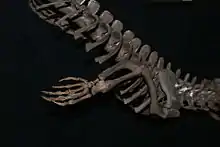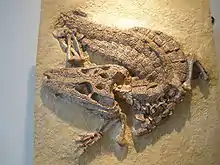Alligatoroidea
Alligatoroidea is a superfamily of crocodilians that evolved in the Late Cretaceous period. Cladistically, Alligatoroidea is Alligator mississippiensis (the American alligator) and all crocodylians more closely related to A. mississippiensis than to either Crocodylus niloticus (the Nile crocodile) or Gavialis gangeticus (the gharial).[1]
| Alligatoroidea | |
|---|---|
 | |
| Alligators (shown above) and caimans are living members of the superfamily Alligatoroidea. | |
| Scientific classification | |
| Kingdom: | Animalia |
| Phylum: | Chordata |
| Class: | Reptilia |
| Order: | Crocodilia |
| Clade: | Brevirostres |
| Superfamily: | Alligatoroidea Gray, 1844 |
| Subgroups | |
Taxonomy

An alligator nest at Everglades National Park, Florida, United States

A. olseni fore limb

Alligator prenasalis fossil
- Superfamily Alligatoroidea
- Family Alligatoridae
- Subfamily Alligatorinae
- Genus † Albertochampsa
- Genus Alligator
- † Alligator mcgrewi
- † Alligator mefferdi
- American alligator, Alligator mississippiensis
- † Alligator olseni
- † Alligator prenasalis
- Chinese alligator, Alligator sinensis
- Genus † Allognathosuchus
- Genus † Arambourgia
- Genus † Ceratosuchus
- Genus † Chrysochampsa
- Genus † Eoalligator
- Genus † Hassiacosuchus
- Genus † Hispanochampsa
- Genus † Krabisuchus
- Genus † Navajosuchus
- Genus † Procaimanoidea
- Genus † Wannaganosuchus
- Subfamily Caimaninae
- Genus Caiman
- Yacare caiman, Caiman yacare
- Spectacled caiman, Caiman crocodilus
- Rio Apaporis caiman, C. c. apaporiensis
- Brown caiman, C. c. fuscus
- Broad-snouted caiman, Caiman latirostris
- † Caiman lutescans
- Genus Melanosuchus
- † Melanosuchus fisheri
- Black caiman, Melanosuchus niger
- Genus † Eocaiman
- Genus † Mourasuchus
- Genus † Necrosuchus
- Genus † Orthogenysuchus
- Genus Paleosuchus
- Cuvier's dwarf caiman, Paleosuchus palpebrosus
- Smooth-fronted caiman, Paleosuchus trigonatus
- Genus † Purussaurus
- Genus Caiman
- Subfamily Alligatorinae
- Family Alligatoridae
References
- Brochu, Christopher A. (May 2003). "Phylogenetic approaches toward crocodylian history". Annual Review of Earth and Planetary Sciences. 31: 360. doi:10.1146/annurev.earth.31.100901.141308.
This article is issued from Wikipedia. The text is licensed under Creative Commons - Attribution - Sharealike. Additional terms may apply for the media files.